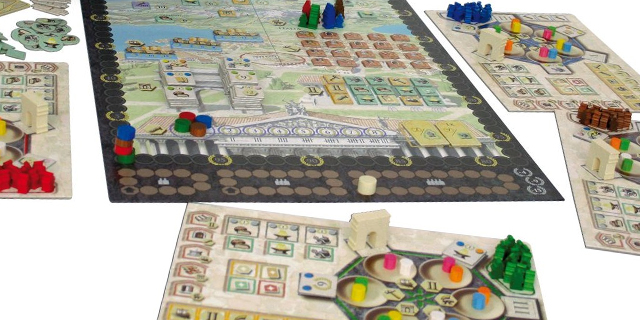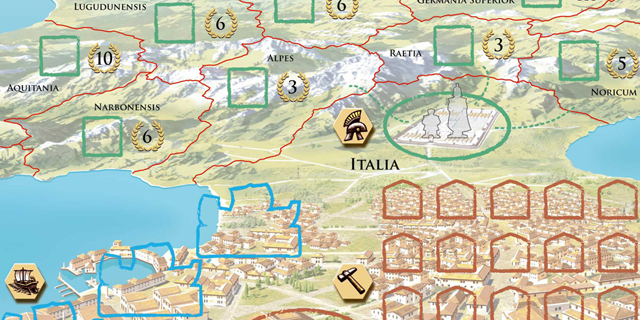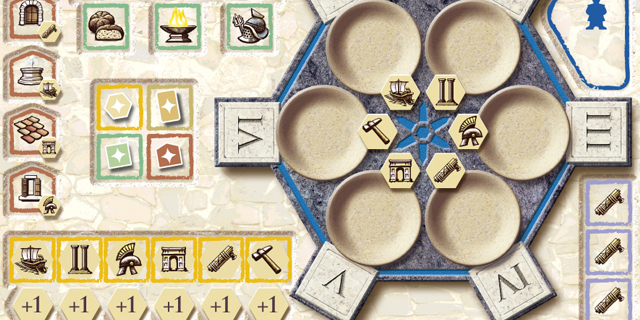
It’s easy to see why Ancient Rome is a fertile inspiration for many game designers. The Romans’ interest in politics, military tactics, art, architecture and religion all offer different elements that can be mixed together into an interesting whole. Stefan Feld’s 2011 title Trajan mixes six aspects of Roman culture, but ties everything together with a mechanic that is decidedly African instead of European.
Each player has a board that predominately features six wells arranged in a circle. Each well has a number of colored cylinders in them, comprised of six different colors. To execute an action each turn, a player selects a well and picks up all of the cylinders from it. They then distribute those cylinders clockwise around the circle one at a time, starting with the well next to the emptied one. The last well in which a cylinder is placed determines the action the player takes.
If that sounds familiar to you, then you’ve probably played the game most popularly known as Mancala (or one derived from it). This game’s origins stretch back to the sixth century, which actually places it several hundred years after the death of Emperor Trajan. Feld uses it in a few of ways in the game itself. First of all, it prevents players from taking the same action too many times in a row thanks to the natural way cylinders accumulate in wells. Secondly, it rewards forward planning by giving players free actions should they manage to deposit correctly-colored cylinders to the right wells.

The final way the Mancala mechanic plays into Trajan is as a timer. Every time a player empties a well, a season marker is advanced a number of spaces equal to the number of cylinders picked up. Whenever the marker makes a complete lap (the specific number of spaces depends on the number of players), the season advances. The game is played over three years of four seasons each. Giving the players a manner of control over how many turns are in the game increases strategic options, while at the same time potentially punishing them if the action they want to take would force them to advance the marker too far too soon.
At the end of each year, players must satisfy the demands of the people. These needs can be any combination of food, entertainment and religion. The specific requirements for each year are revealed at the end of each of the first three seasons each year. Failure to meet these demands carries a stiff VP penalty, especially if you lack more than one. You have to manage your actions carefully to balance gaining points with preventing the loss of them.
Each individual action usually carries a number of choices. Forum actions are the among the most straight-forward, simply allowing you to take a tile of your choice from the pool available (refreshed each year). These tiles include demands, additional actions, senate votes or wild cards that can be used as any other tile of the appropriate type. Equally simple is the Senate action, which just advances your marker on the vote track and scores you VP each time you take it. At the end of each year players compare number of votes (including senate tiles, if any); the player with the most gains one of the two bonus tiles of his choice, and second place takes the other but flips it to its lesser-valued side. These bonus tiles will heavily influence your strategy, as winning without using them will be difficult.

Military actions get a little more complicated, as a player can either move the leader to an adjacent region on the map (claiming any tile that might be present), place a lieutenant in the leader’s current region for VP or advance a worker to the lieutenant pool. Similarly, construction actions allow you to either advance a worker to the builder pool or place a builder on one of the construction sites adjacent to one of their previously-placed builders (or anywhere for their first). If a tile is on that site the player claims it and scores its points. Claiming the first of a given type of tile also provides a corresponding free action, and having sets of three or four of the same tile is worth big points at the end of the game. Blocking other players from accomplishing this is both important and relatively easy to do, but is sacrificing your own plans worth it?
Another good source of points is the Port action. Taking this action allows you to draw a commodity card from one of the face-up piles, draw two from the face-down deck but discard one of your choice to one of the face-up piles, or trade in sets of cards for points. There are three different styles of sets (identical sets, unique sets and unique pair sets) worth different amounts of points. The first player to cash in a specific type of set forces everyone else (including themselves) to score fewer points for the same type for the rest of the year. Scored commodity cards are the most common requirement for bonus tiles gained in the Senate, but there are a ton of different cards and only two per Senate tile, so it can be difficult — but insanely rewarding — to really rack up points here.

Finally, Trajan actions allow you to take a Trajan tile and place it next to one of your board’s wells. If, when you take your action, you manage to have the right two cylinders in that action’s well you can gain the effect of that well’s Trajan tile, if any. These tiles can permanently satisfy one class of demand, enhance your bonus actions, advance workers to either the military or construction pools, draw commodity cards, or simply score extra points.
It seems like there’s a lot going on in Trajan, but once you get playing, everything mostly revolves around managing your wells. If you can get control over that everything else should follow, although strategic decisions lurk in every corner. With the only true randomness coming from card and tile shuffles, Trajan is a game that rewards planning at every level.
Trajan retails for $70 and supports two to four players, with an estimated play time of 30 minutes per player.



















